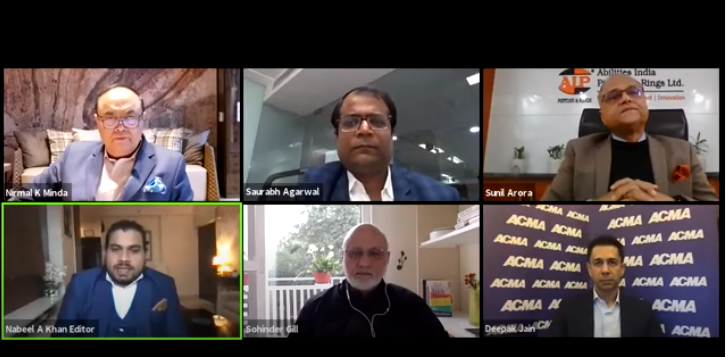
New Delhi: Ahead of the expected launch of production-linked incentive (PLI) schemes on December 31, 2020, the veterans of Indian auto component industry has urged the government to do a fresh round of consultation with the industry since it is imperative that this scheme should be rolled out after adequate deliberations with the domestic auto parts suppliers.
In a live panel discussion on ‘What to expect from the Production Linked Incentive Scheme for the Auto Sector’, organised by ETAuto.com, the industry leaders also emphasised the need for sharing the draft policy with the Automotive Component Manufacturers Association (ACMA) if the industry has to reap the full benefits of the scheme.
“We are still not clear how much benefit the auto component industry will get as the scheme covers the overall auto industry. We request the government to give the draft policy to ACMA so that we can discuss and propose it to the concerned authorities,” Nirmal K Minda, chairman and managing director of the tier-I auto component manufacturing company UNO Minda, said. A split should be there on allocation of funds between auto industry and auto component industry, he added.
We need to create a industry format within ACMA so that we all work togetherSunil Arora, managing director of Abilities Indian Piston & Rings
Echoing similar sentiment Deepak Jain, president ACMA, said “Largely the value addition and revenue is going to come from the component sector. Therefore, industry needs to deliberate how the funds should be distributed between the OEMs and the ancillary industries.” ACMA, an apex body which represents the interest of 830 domestic auto component makers, contributes more than 85% of the auto component industry’s turnover in the organised sector.
Prior to the unveiling of the PLI scheme, the government met the representatives of two apex industry bodies, ACMA and the Society of Indian Automobile Manufacturers (SIAM), to discuss the localisation initiatives. “A lot has changed since our last deliberation in July. We saw a very fast recovery but the key point for the government and the industry is how can we get the growth back,” Jain added.
Since its announcement, speculations and plenty of guess works are doing the rounds with the industry with regard to who will get the benefit and to what extent. While industry is certain that intent is to boost automotive manufacturing, many fear the scheme will ignore MSMEs.
Notably, PLI scheme has laid out eligibility criteria of INR 1,000-crore turnover, INR 200-crore of exports and investment of INR 350 crore in fixed assets. This stringent rule leaves out many small players of the industry.
Panelists, however, hold a slightly different view and said that the ultimate intent is to provide benefit to the complete value chain. According to Saurabh Agarwal, partner, EY, the objective of the government is to promote champions and make big champions. Once the bigger ones will grow, automatically MSME will grow, he noted.
“There will be a ripple effect. For instance if there is a tier-I auto component maker, it has to source the child part from tier-II and tier-III manufacturers. So in the end that revenue is going to come to the MSME. The profits for MSME will also grow,” Agarwal added.
“There were certain boundary conditions which were laid by the authorities stating that this kind of production linked incentive should be given to certain champions which have the scale and capability of investing in the future so that they can take a very significant portion in the whole global value chain,” Jain pointed out.
Other auto component manufacturers in the panel said that the incentives will help the sector to reduce import and become net-exporters. “The MSME players are largely export driven. We need to create a industry format within ACMA so that we all work together in furthering the cause where in the MSME get together with the large players and make it more inclusive so that the deliverables of the government are achieved within the said time frame,” Sunil Arora, managing director of Abilities Indian Piston & Rings, said.
Through PLI scheme, the objective of the government is to promote champions and make big champions.Saurabh Agarwal, partner, EY
Hailing the scheme Sohinder Gill, director general, SMEV, said that although the scheme does not benefit the OEMs in EV space much the outlay of INR 18,100 crore for advanced chemistry cell batteries will definitely boost local battery manufacturing.
“China is really becoming so overpowering in batteries. Due to geo-political compulsions or cost compulsions if we want to be self-dependent on batteries then schemes like PLI must be taken into consideration,” Gill highlighted.
Last month, the Union government approved a production-linked incentive scheme worth up to INR 1.45 lakh crore for 10 key manufacturing sectors. Out of this the largest share is allocated to automobiles and auto components, a maximum incentive of about INR 57,000 crore.
The Automobile Industry in India accounts for 7.1% to the country’s GDP and around 49% to India’s manufacturing GDP as of 2019. It became the fifth-largest auto market in 2019 with sales reaching 3.81 million units. The automobile industry is one of the largest employment providers in the country and employs close to 29 million people across the country
Lauding some elements of the policy, the ACMA resident said that through this scheme the intent of the government is very clear – Make in India, Localise in India and also create more value addition in India. “The whole idea to make the industry competitive is to get the scale. Maybe it is a good time for the auto industry to reflect how we should use the domestic capital and foreign capital in different lenses so that we are able to have the best advantage which basically both the entities of the domestic and the foreign can get,” Jain said.














